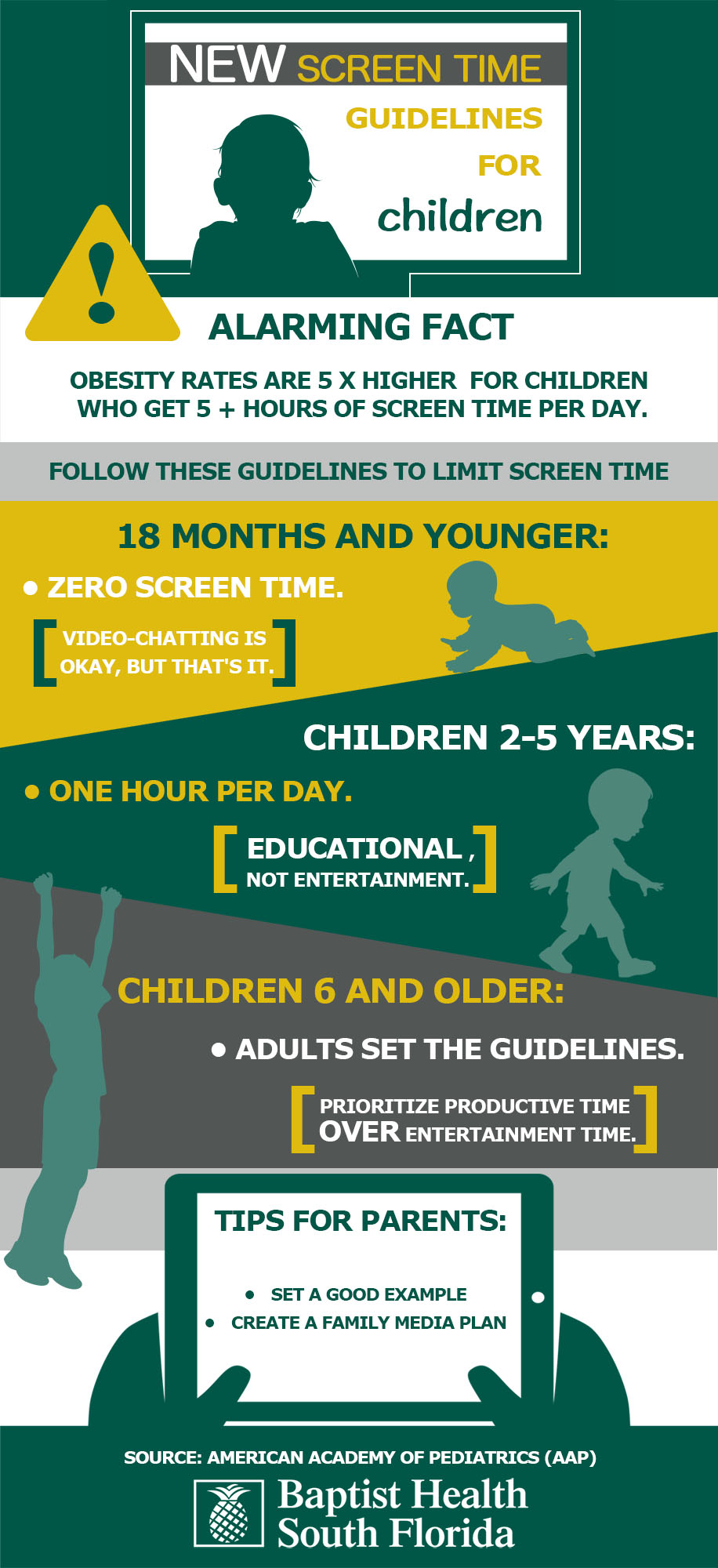April 7, 2020 by John Fernandez
New Screen Time Guidelines for Children (Infographic)

Daily screen time for kids on electronic devices and television needs to be limited, according to the American Academy of Pediatrics (AAP).
At its recent annual meeting, the AAP issued strong recommendations for parents to follow as concern grows over the link between too much screen time and poor health in children and adolescents. Thee AAP is an organization with a membership of 66,000 pediatricians nationwide. The new guidelines do allow for some screen time for kids that includes educational media.
Currently, children spend on average seven hours a day on entertainment media, which includes television, computers, phones or other electronic devices. This added time in front of the screen has been linked to higher obesity rates in children who spend five hours or more in front of a screen, as compared to those who spend two hours or less.
Javier Hiriart, M.D., a pediatrician and physician with Baptist Health Primary Care, says that using electronic devices in moderation won’t harm children. But he added that some kids, especially preteens and teenagers, spend too much time in the virtual world and engage too little in human interaction. In this situation, he says, intervention is warranted.
“Anything in moderation is usually OK,” Dr. Hiriart said. “We should insist upon a variety of activities to keep them engaged in the real world.”
Another health concern is the amount of sleep that kids and adolescents are getting. Studies have shown that there is greater risk of sleep deprivation or disturbances in sleeping patterns due to exposure to screen light prior to bedtime. An electronic devices’ “blue light,” in particular, affects the melatonin levels in the brain, which is responsible for helping bodies sleep.
(See infographic and scroll down to continue reading. Infographic by Alcyene C. de Almeida Rodrigues.)

18 Months and Younger – Zero Screen Time
It has always been the recommendation that those who are in this age group receive no screen time, especially solo time. However, studies are showing that during this critical time for development some screen time with parental supervision can help form certain bonds. Skype or Face Time, for instance, are excellent tools for connecting young children with family members.
Children 2-5 Years – One Hour per Day
This is where the new guidelines begin to change from the previous two hours per day rule. Children in this age group benefit from limited amounts of screen time — as long as the media to which they are exposed is educational. Shows such as “Sesame Street” and similar programming provide this benefit. However, the downfall is that the ‘screen’ becomes a “baby sitter” at this age as parents become more involved in their own busy schedules. This is a crucial time in young children’s lives where some developmental delays can occur without proper interaction.
Children 6 Years and Older – Parents Set the Guidelines
It is important to make sure that screen time is productive time, instead of entertainment time. Children at this age often need to use a computer to complete homework assignments. The average day of an adolescent should consist of school, homework, at least one hour of physical activity, social contact and sleep. Eight to twelve hours of sleep is recommended. The rest of the time can be screen time, which works out to about two to three hours available each day.
Parents as Role Models
To be good role models, parents need to disconnect too. Recommendations include, establishing media-free times, such as family dinner and time set aside prior to bedtime. This helps strengthen the bonds between parents and children. “We also have to set a good example for our kids. It’s difficult in today’s society, but kids follow our lead,” says Dr. Hiriart.
For more information about how to set plans in motion in your household, refer to the Family Media Plan from the American Academy of Pediatrics.
top stories












There are no comments